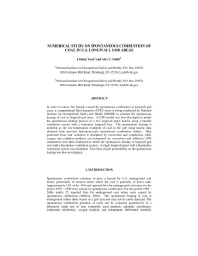Mining Publication: Numerical Study on Spontaneous Combustion of Coal in U.S. Longwall Gob Areas
Original creation date: November 2009
Authors: L Yuan, AC Smith
NIOSHTIC2 Number: 20036226
Proceedings of the Ninth International Mine Ventilation Congress, New Delhi, India, November 10-13, 2009. Panigrahi DC, ed., New Delhi, India: Oxford & IBH Publishing Co. Pvt. Ltd., 2009; :263-271
In order to reduce fire hazards caused by spontaneous combustion in longwall gob areas, a computational fluid dynamics (CFD) study is being conducted by National Institute for Occupational Safety and Health (NIOSH) to simulate the spontaneous heating of coal in longwall gob areas. A CFD model was first developed to model the spontaneous heating process in a two longwall panel district using a bleeder ventilation system with a stationary longwall face. The spontaneous heating is modeled as the low-temperature oxidation of coal in the gob using kinetic data obtained from previous laboratory-scale spontaneous combustion studies. Heat generated from coal oxidation is dissipated by convection and conduction, while oxygen and oxidation products are transported by convection and diffusion. CFD simulations were then conducted to model the spontaneous heating in longwall gob area with a bleederless ventilation system. A single longwall panel with a bleederless ventilation system was simulated. The effect of gob permeability on the spontaneous heating was also investigated.

NIOSHTIC2 Number: 20036226
Proceedings of the Ninth International Mine Ventilation Congress, New Delhi, India, November 10-13, 2009. Panigrahi DC, ed., New Delhi, India: Oxford & IBH Publishing Co. Pvt. Ltd., 2009; :263-271
- Analysis and Design Considerations for Superimposed Longwall Gate Roads
- Degasification System Selection for U.S. Longwall Mines Using an Expert Classification System
- Development of Stress Measurements and Instrument Placement Techniques for Longwall Coal
- Modeling and Prediction of Ventilation Methane Emissions of U.S. Longwall Mines Using Supervised Artificial Neural Networks
- Numerical Study on Effects of Coal Properties on Spontaneous Heating in Longwall Gob Areas
- Overview of Coal Mine Ground Control Issues in the Illinois Basin
- Reservoir Engineering Considerations for Coal Seam Degasification and Methane Control in Underground Mines
- SPONCOM - A Computer Program for the Prediction of the Spontaneous Combustion Potential of an Underground Coal Mine
- SponCom - Spontaneous Combustion Assessment Software - 2.0
- Technology News 545 - NIOSH Updates Spontaneous Combustion Assessment Software